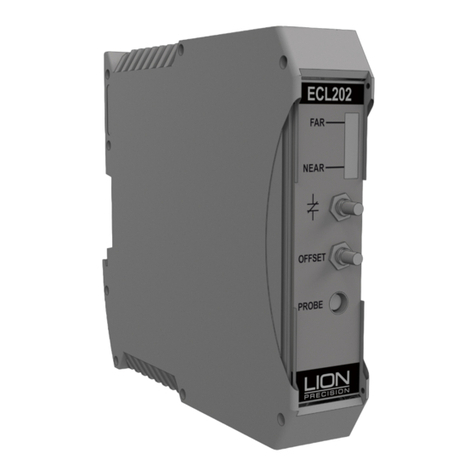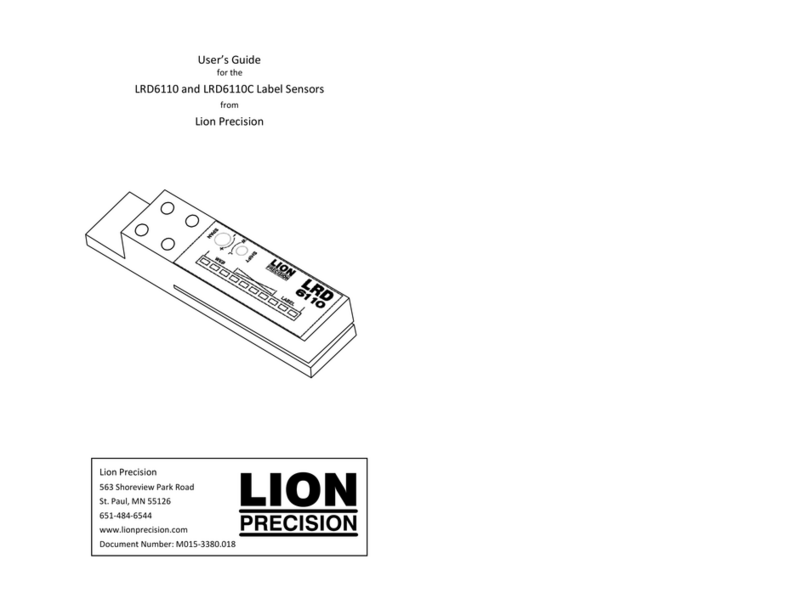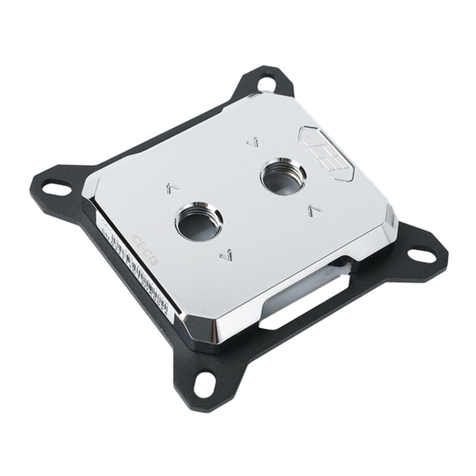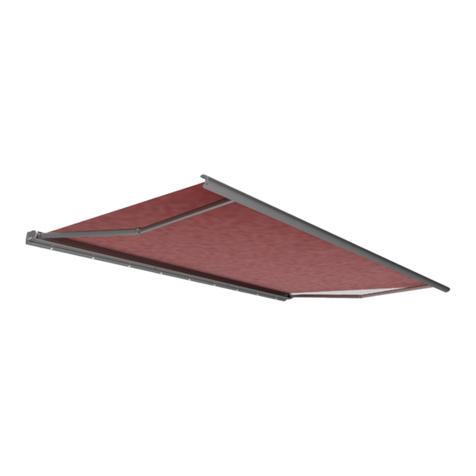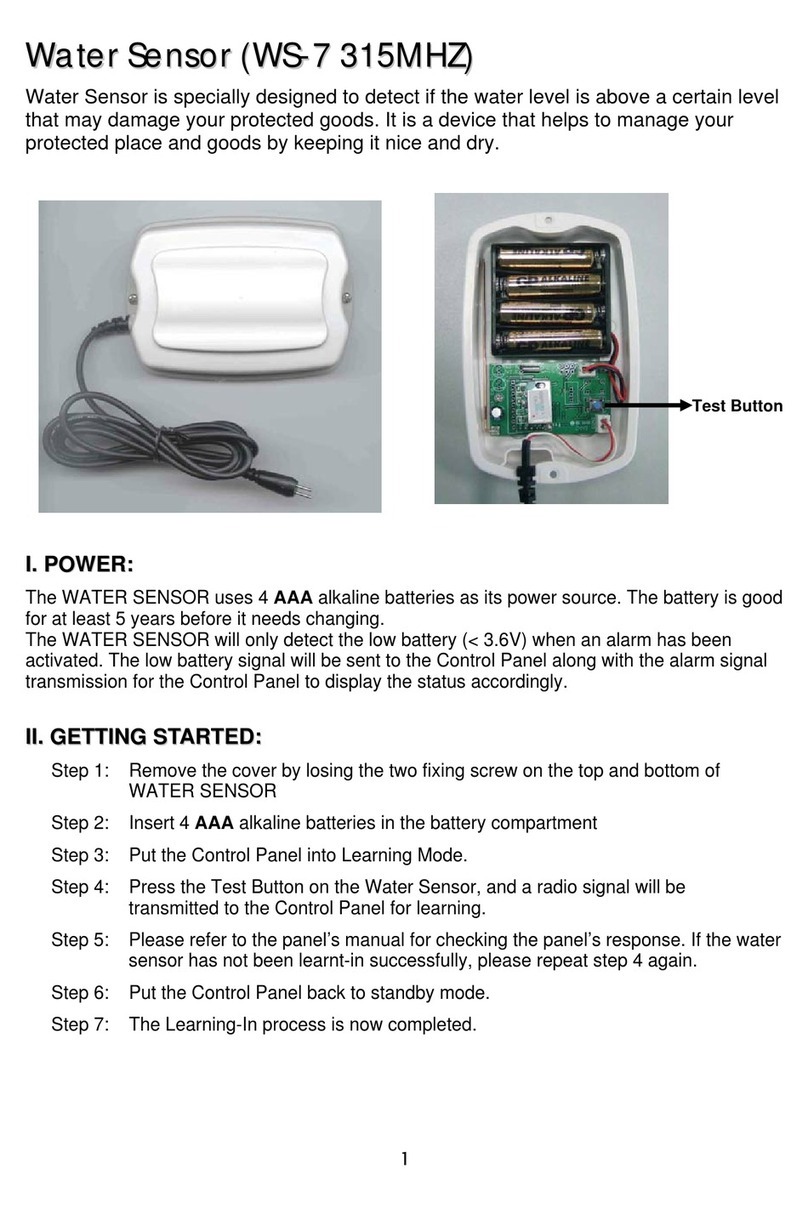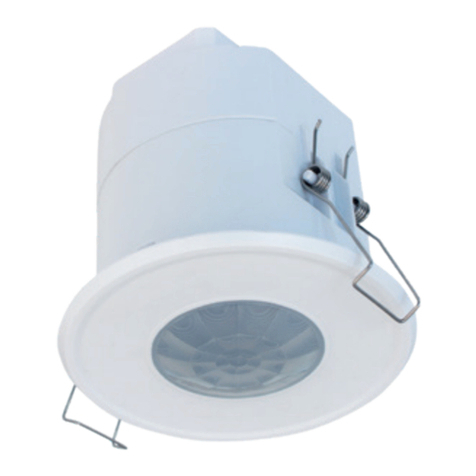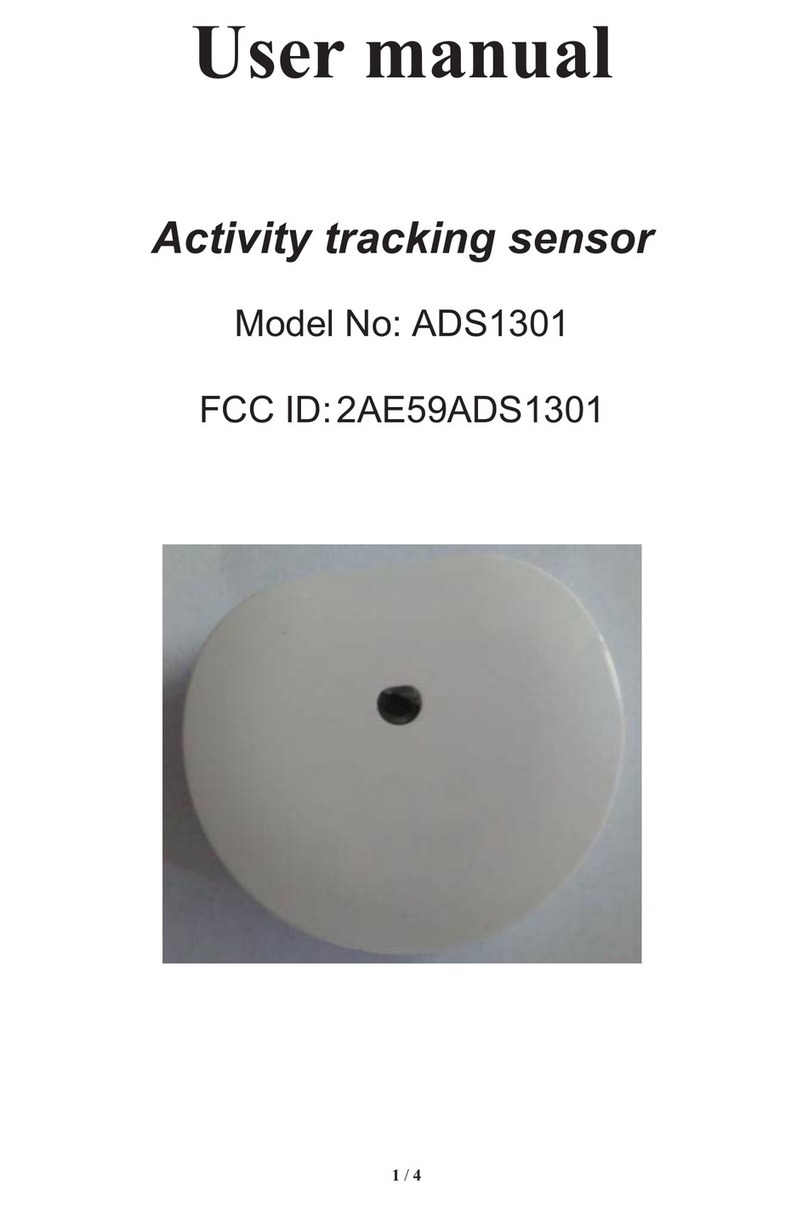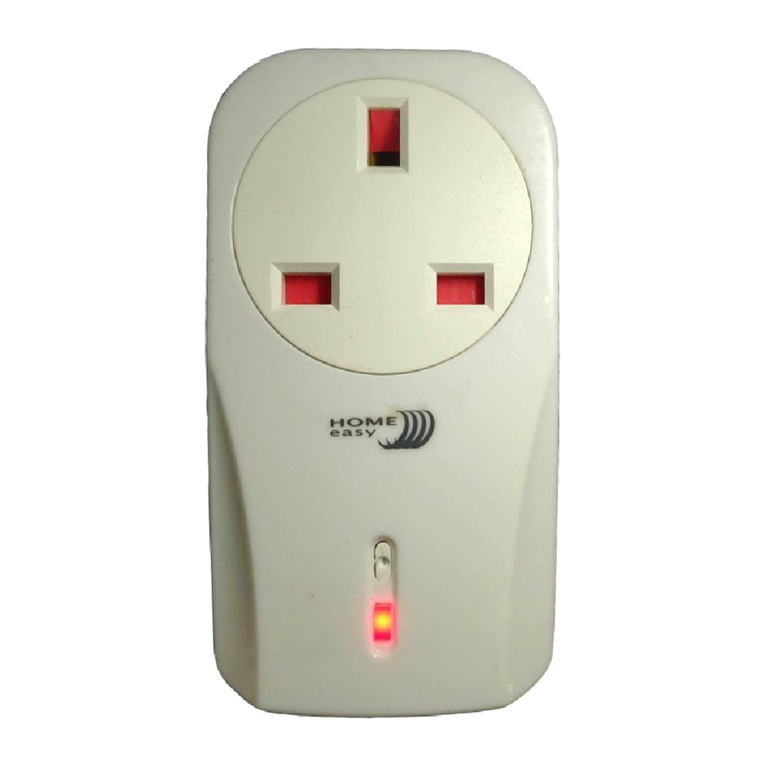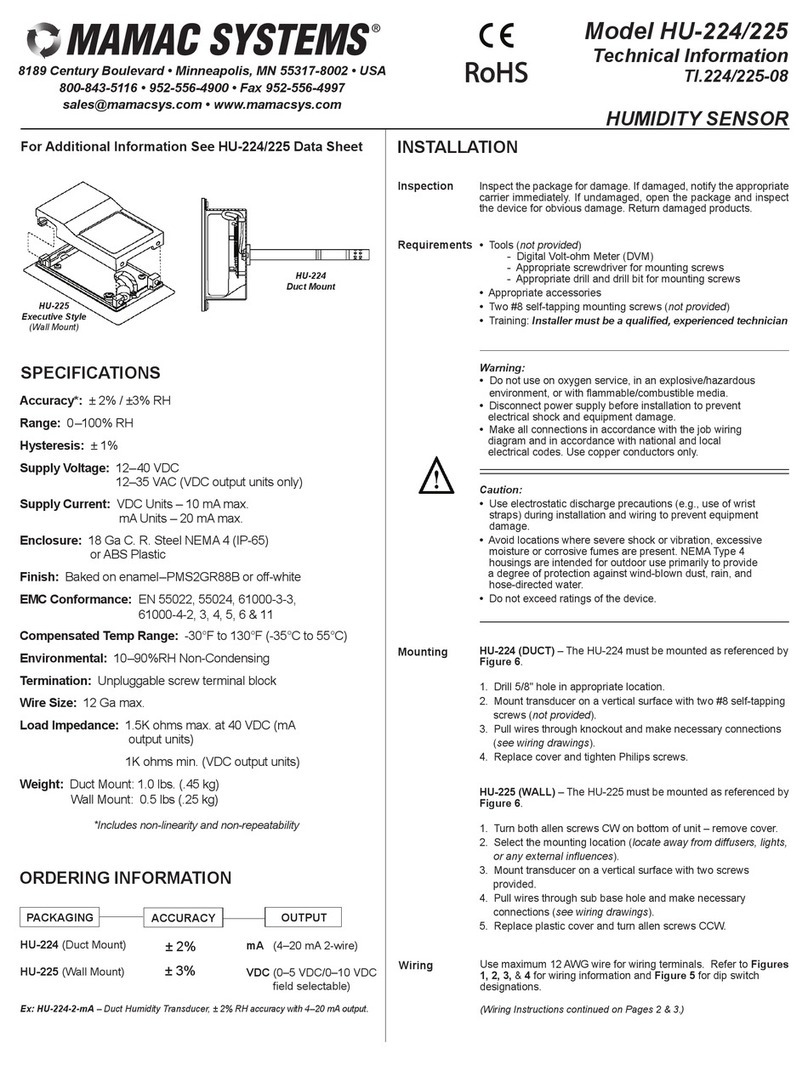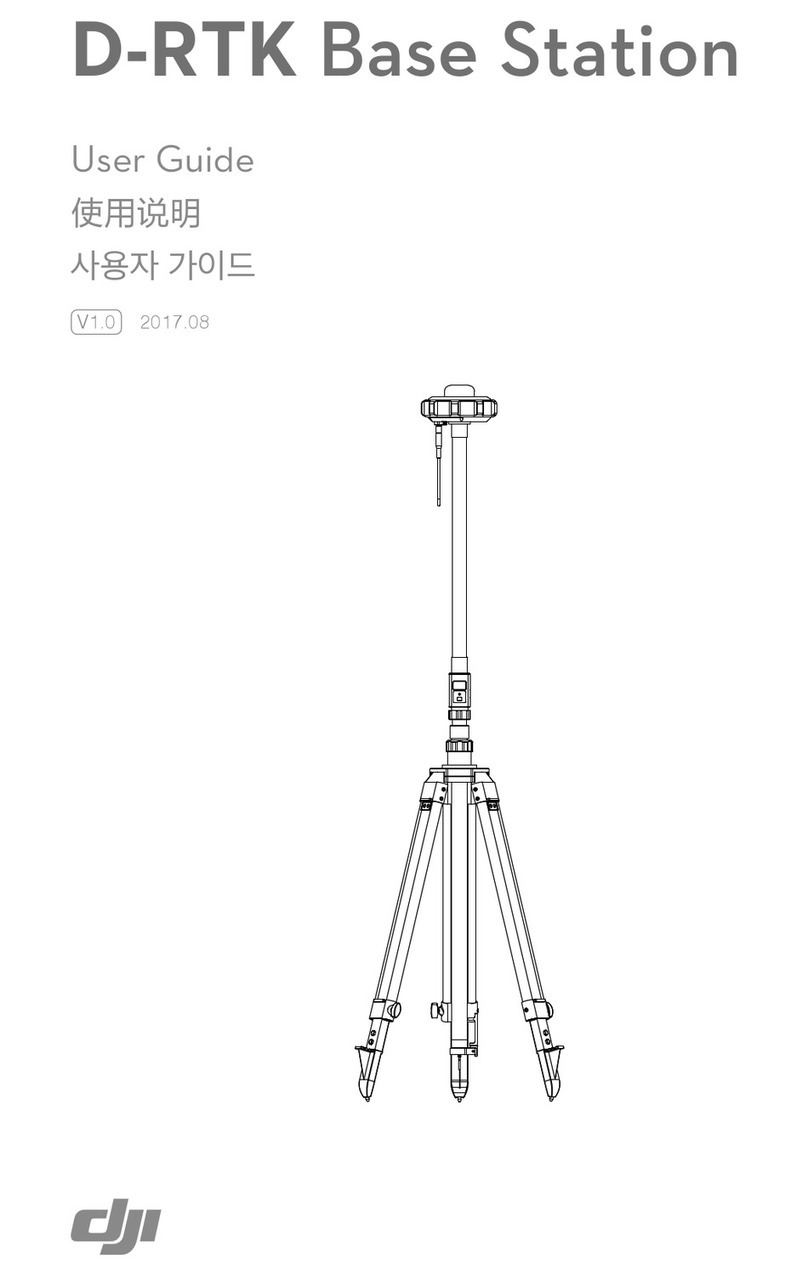Lion Precision Elite Series User manual

INSTRUCTION
MANUAL Elite Series
Capacitive
Sensor
Systems
CPL190 • CPL290 • CPL490 • MM190 • TMP190 • EN190
Lion Precision • 563 Shoreview Park Road • St. Paul, Minnesota 55126-7014
Telephone: 651-484-6544 • Fax: 651-484-6824 • www.lionprecision.com
Copyright © 2015 All Rights Reserved Document M015-9450.021

2
Table of Contents
Approvals and Safety Considerations..........................................................................................................................................3
Probe Tip Contact Caution ......................................................................................................................................................3
Helpful Technical Support Documents Online............................................................................................................................3
CPL190/290 Sub-Nanometer Capacitive Displacement Sensor ..................................................................................................4
Overview of Front Panel Controls, Indicators, and Connectors ..............................................................................................5
Multiple Channel Measurements .............................................................................................................................................5
CPL190/290 Specifications .....................................................................................................................................................6
CPL490 Wide Bandwidth Picometer Capacitive Displacement Sensor ......................................................................................7
Overview of Front Panel Controls, Indicators, and Connectors ..............................................................................................8
Multiple Channel Measurements .............................................................................................................................................8
CPL490 Specifications ............................................................................................................................................................9
Changing CPL190/290/490 Bandwidth Settings .......................................................................................................................10
MM190 Meter and Function Module ........................................................................................................................................11
MM190 Specifications...........................................................................................................................................................12
TMP190 Temperature Sensing and Encoder/Index Input Module ............................................................................................13
TMP190 Temperature Specifications1...................................................................................................................................14
Encoder/Index Pulse Input.....................................................................................................................................................15
Elite Series Enclosures...............................................................................................................................................................17
Power Specifications .............................................................................................................................................................17
EN191, EN192, EN193 Power Connector.............................................................................................................................18
External Power Supply ..........................................................................................................................................................18
DAQ Connector Pinout..........................................................................................................................................................19
Mechanical Specifications: EN191, EN192, EN193 .............................................................................................................20
Mechanical Specifications: EN196, EN198...........................................................................................................................21
Accessories ................................................................................................................................................................................22
Air-Bearing C-LVDT: Capacitive LVDT-Type Contact Sensor ...........................................................................................22

3
Approvals and Safety Considerations
The Elite Series is compliant with the following CE standards:
Safety: EN 61010-1:2010
EMC: IEC 61326-1:2013, IEC 61326-2-3:2013
To maintain compliance with these standards, the following operating conditions must be maintained:
●All I/O connecting cables must be shielded and less than three meters in length
●AC power cables must be rated at a minimum of 250 V and 5 A
●AC power must be connected to a grounded mains outlet rated less than 20A
●Use the included CE approved power supply with 1-, 2-, and 3- slot enclosures. If an alternative power supply is
used, it must have equivalent CE certification and provide safety isolation from the mains according to IEC60950 or
61010.
●Sensors must not be attached to parts operating at hazardous voltages in excess of 33VRMS or 70VDC
Use of the equipment in any other manner may impair its safety and EMI protections.
Probe Tip Contact Caution
The sensing tips of capacitive probes produce voltages as high as 70 Vrms. These are high frequency voltages with very low
power so they pose no danger. Normally when the probe tip is touched, the probe stops functioning and voltage is reduced to
near zero. But under certain circumstances, the voltage may cause a slight tingle or burning sensation, especially with the
second generation probes used with the CPL490. For maximum performance probe tips should remain free of oils or other
contaminants.
For these reasons, it is recommended the probe tips not be touched.
Helpful Technical Support Documents Online
Lion Precision’s web site has a large selection of technical documents (TechNotes and Application Notes) in the Technical
Library. These documents provide detailed descriptions of the operation and use of Lion Precision high-performance sensors.
The Technical Library can be accessed at:
www.lionprecision.com/tech-library
Some of the titles include:
Understanding Sensor Resolution Specifications and Effects on Performance
Capacitive Sensor Theory of Operation
Error Sources: Probe/Target Angle
Capacitive Sensors in Vacuum
Capacitive Sensor Phasing and Ungrounded Targets
Capacitive Probe Cabling Considerations
Elite Series Phase/Amplitude Frequency Response
Z-Height Measurement with Capacitive and Eddy-Current Sensors
Thickness Measurement with Capacitive Sensors
Glue Sensing with Capacitive Sensors

4
CPL190/290 Sub-Nanometer Capacitive Displacement Sensor
The CPL190/290 Capacitive Sensor is a precision, noncontact measurement device. The
output voltage changes in direct linear proportion to changes in the gap between the probe
and the target. The sensor is normally used to measure conductive targets, but it can also
be used with nonconductive targets under the right conditions. For more information
about measuring nonconductors, visit the Technical Library at www.lionprecision.com or
call for assistance.
The CPL190/290 works with most Standard Probes.
Basic Operation
The output voltage is accessed via the front panel BNC connector, or by a data acquisition
system via the high-density connector on the rear of the enclosure. This connector can
connect directly to National Instruments™ data acquisition products. See the enclosure
section of this manual for specifics on the system DAQ connector (page 19).
As the gap between the probe and target changes, the output voltage will change
accordingly. As the probe approaches the target, the output voltage will become more
positive.
Note: Calibrated Range “Near” and “Far” lights (red) indicate that the
probe is out of its calibrated range and the output is not guaranteed to be
accurate even though the voltage may be in range and continue to
change.
Probes are calibrated to specific modules. With multiple channel systems, be sure the number on the probe cable (near the
connector) matches the number on the module handle.
The CPL290 provides low and high sensitivity calibrations for a single probe. Use the Sensitivity switch to select the desired
sensitivity. Calibration detail is provided on calibration sheets shipped with the product.
Noncontact sensors normally measure changes from a reference position.
Making a basic measurement
1. Connect probe to module
2. Set the target to a reference position or condition
3. Mount probe near target
4. Adjust the probe position until the “Calibrated Range” indicator is at center position
5. Use the Zero adjustments to adjust the output voltage to zero (optional)
6. As the probe/target gap changes, the output voltage will change accordingly
Interpreting the output voltage
The amount of change of the output voltage for a given change in the probe/target gap is called Sensitivity. The sensitivity of
the sensor is listed on the calibration sheets which arrived with the sensor.
Change in gap calculation:
Gap Change = Voltage Change / Sensitivity
For example: With a sensitivity of 1 V/2 µm and a voltage change of 3 V, the gap change would be 6 µm (3/0.5).
CPL190
ZERO
NEAR
CALIBR ATED RANG E
OUTPUT
PROBE
FAR
OFF ON

5
Overview of Front Panel Controls, Indicators, and Connectors
Zero Adjust
Adjusts the analog output voltage after the probe is initially positioned. Typically, the analog
output voltage is adjusted to zero volts at range center. There is a coarse adjustment (±10 VDC),
the outer control, and a fine adjustment (±1 VDC), the inner control. When the Zero switch is in
the off position, the zero adjustment has no effect.
Sensitivity (CPL290 Only)
The CPL290 provides a high-sensitivity and a low-sensitivity calibration for one probe. Refer to
the calibration sheets for specific calibration information. Select the desired sensitivity with this
switch.
Switching sensitivities will usually require repositioning the probe.
Calibrated Range Indicator
Green LEDs indicate that the probe is in its calibrated range and the output voltage is an
accurate representation of the target position. Red LEDs indicate that the probe is out of range
and the output voltage is not valid.
The Calibrated Range Indicator is not affected by the Zero adjustment. The module is factory
calibrated to zero volts at range center, however, it is possible to adjust the output voltage to
zero while the probe is positioned toward the end of the calibrated range. In this situation, the
probe can go out of its calibrated range while the output voltage continues to appear valid. The
output voltage may continue to change, but the output is no longer guaranteed to be accurate. In
this condition, the output voltage may appear valid but the Calibrated Range Indicator will be
red. Out-of-Range indicator signals available through the system DAQ connector are activated
anytime the Calibrated Range Indicator is red.
Analog Output
Provides connection to the analog output voltage, which is proportional to the distance between the probe and the surface of
the material being measured. A typical output voltage range is ±10 VDC. The specific ranges are listed on the accompanying
calibration sheets.
The analog output provided on the data acquisition (DAQ) connector on the rear of the enclosure is differential. See the
enclosure section of this manual for specifics on the system DAQ connector (page 19).
Ground
A banana-plug cable can be connected here for grounding the target. In most cases, separate grounding of the target is not
necessary. If the target is not grounded through another path, and the output exhibits excessive electrical noise, grounding the
target may reduce the output noise. When low-noise operation is critical, separate grounding is recommended even if the
target is well grounded through another path.
Probe Connector
Connect the probe by aligning the red dots on the connectors and inserting the probe connector.
To disconnect the probe, pull on the knurled barrel of the probe connector to release it.
DO NOT PULL ON THE CABLE.
Multiple Channel Measurements
Using multiple sensors on the same target requires that the sensor excitation voltages be synchronized. This is done
automatically by the Elite Series enclosures. In addition, even and odd channel numbers use inverted (180°) excitation
CPL290
ZERO
SENSITIVITY
HI LO
NEAR
CALIBRATED RANGE
OUTPUT
PROBE
FAR
OFF ON
LION
PRECISION

6
voltages. This eliminates offset and scale errors that may otherwise occur with poorly grounded targets such as
semiconductors. For details on use with ungrounded targets and the advantage of inverted excitation voltages, refer to Lion
Precision TechNote LT03-0022 Capacitive Sensors and Ungrounded Targets, available at www.lionprecision.com; click on
Technical Library.
CPL190/290 Specifications1
Linearity Error ±0.2% F. S. or better, dependent on calibration
Error Band ±0.3% F. S. or better, dependent on calibration
Standard Bandwidth (-3 db) 15 kHz -10%+30%
Coarse Zero Adjustment Range ±10 VDC
Fine Zero Adjustment Range ±1 VDC
Meets ANSI/ASME B5.54
Standard
Yes
Probe Interchangeability Typical sensitivity variation for same probe model: 10%
Operating Temperature 4°-50°C
Thermal Stability 0.02% F.S./°F, 0.04% F.S./°C
Typical Oscillator Frequency Probe cable < 12 feet: 1 MHz
Probe cable > 12 feet: 500 kHz
Output Impedance 0 Ω
Output Max Voltage ±13.5 VDC
Output Max Current 10 mA
1These specifications are typical for standard components and calibrations. Customizations can effect performance. Check
the calibration sheet shipped with the product for specific details on your system.
In high EMI environments (10 V/m), output noise may rise to 0.2 VRMS (1% resolution) and DC output may shift.

7
CPL490 Wide Bandwidth Picometer Capacitive Displacement Sensor
The CPL490 Capacitive Sensor is a very high precision, noncontact measurement
device. The output voltage changes in linear proportion to changes in the gap
between the probe and the target. The sensor is normally used to measure
conductive targets, but it can also be used with nonconductive targets in some
applications. For more information about measuring nonconductors, visit the
Technical Library at www.lionprecision.com or call for assistance.
The CPL490 only works with 2nd Generation Probes which include integral
electronics.
Basic Operation
The output voltage is accessed via the front panel BNC connector, or by a data
acquisition system via the high-density connector on the rear of the enclosure. This
connector can connect directly to many National Instruments™ data acquisition
products. See the enclosure section of this manual for specifics on the system DAQ
connector (page 19).
As the gap between the probe and target changes, the output voltage will change
accordingly. As the probe approaches the target, the output voltage will become
more positive.
Note: “Near” and “Far” lights (red) indicate that the probe is out of its calibrated range and the output is not
guaranteed to be accurate even though the voltage may continue to change.
Probes are calibrated to specific modules. With multiple channel systems, be sure the number on the probe cable (near the
connector) matches the number on the module handle. Calibration detail is provided on calibration sheets shipped with the
product.
Noncontact sensors normally measure changes from a reference position.
Making a basic measurement
1. Connect probe to module
2. Set the target to a reference position or condition
3. Mount probe near target (probes should be mounted by the 8 mm diameter probe body which extends from the
larger probe electronics housing)
4. Adjust the probe position until the Near/Far indicator is at center position
5. Use the Zero adjustments to adjust the output voltage to zero (optional)
6. As the probe/target gap changes, the output voltage will change accordingly
Interpreting the output voltage
The amount of change of the output voltage for a given change in the probe/target gap is called Sensitivity. The sensitivity of
the sensor is listed on the calibration sheets which arrived with the sensor.
Change in gap calculation:
Gap Change = Voltage Change / Sensitivity
For example: A sensitivity of 1 V/2 µm and a voltage change of 3 V, the gap change would be 6 µm (3/0.5).

8
Overview of Front Panel Controls, Indicators, and Connectors
Zero Adjust
Provides a DC shift of the analog output voltage after the probe is initially positioned. The
adjustment has a range of ±1 VDC. Typically, the analog output voltage is adjusted to zero volts at
range center. When the Zero switch is in the off position, the zero adjustment has no effect.
Calibrated Range Indicator (Near Far)
Indicates where the probe is within its calibrated range. Green LEDs indicate that the probe is in its
calibrated range and the output voltage is an accurate representation of the target position. Red LEDs
indicate that the probe is out of range. When the probe is out of range, the output voltage may not be
an accurate indication of the target position even if it is still within the ±10 VDC range. The Zero
adjust has no effect on the Calibrated Range Indicator.
Analog Output
Provides connection to the analog output voltage, which is linearly proportional to the distance
between the probe and the surface of the object being measured. A typical output voltage range is
±10 VDC. The specific range is listed on the calibration sheet shipped with the device.
The analog output provided on the data acquisition (DAQ) connector on the rear of the enclosure is
differential. See the enclosure section of this manual for specifics on the system DAQ connector
(page 19).
Ground
A banana-plug cable can be connected here for grounding the target. In most cases, separate
grounding of the target is not necessary. If the target is not grounded through another path, and the
output exhibits excessive electrical noise, grounding the target may reduce the output noise. When
low-noise operation is critical, separate grounding is recommended even if the target is well
grounded through another path.
Probe Connector
Connect the probe by aligning the red dots on the connectors and inserting the probe connector.
To disconnect the probe, pull on the knurled barrel of the probe connector to release it.
DO NOT PULL ON THE CABLE.
Multiple Channel Measurements
Using multiple sensors on the same target requires that the sensor excitation voltages be appropriately selected. Systems
ordered for multiple channel use on the same target will be specially calibrated to avoid inter-channel interference. Using
multiple CPL490s together which are not so calibrated may produce interference in the output voltages of all channels.
Sensors that will be used together to measure the same object must be ordered together so they can be appropriately
calibrated. Using multiple sensors not so calibrated may not provide accurate results.

9
CPL490 Specifications1
Linearity Error 0.2% F.S.
Error Band 0.3% F.S.
Bandwidth (-3 db) Selectable: 1 kHz, 10 kHz, 15 kHz, 50 kHz
Bandwidths are -10%+30%
Meets ANSI/ASME B5.54
Standard
Yes
Operating Temperature 15-40 °C
Thermal Stability 0.02-0.04% F.S., Probe/Range dependent
Oscillator Frequency Probe/Calibration dependent. 6.4 MHz typical.
Output Impedance 0 Ω
Output Max Voltage ±13.5 VDC
Output Max Current 10 mA
1These specifications are typical for standard components and calibrations. Customizations can affect performance. Check
the calibration sheet shipped with the product for specific details on your system.
In high EMI environments (10 V/m), output noise may rise to 0.5 VRMS and DC value may shift 0.7 VDC.

10
Changing CPL190/290/490 Bandwidth Settings
The CPL190/290/490 provides a two-position DIP switch for setting bandwidth.
When changing bandwidth, change all modules in the system.
Bandwidth is a system-wide setting; bandwidth switches on the
modules within a system are interconnected.
All of the bandwidth switches must be in the same position for
predictable results.
This switch is located as shown in the drawings at the right. The following table
shows the bandwidths available and their associated dip switch settings.
Bandwidths listed are approximate. Actual values depend on the probe and
calibration.
CPL190/290
(S2) CPL490
(S1) 2 1 Notes
15 kHz 50 kHz OFF OFF Computer control of bandwidth
requires this setting (OFF, OFF)
10 kHz 15 kHz OFF ON
1 kHz 10 kHz ON OFF
100 Hz 1 kHz ON ON
Bandwidth DIP Switch Access
Be careful to only change switches and jumpers as directed in this manual. Any other changes will affect the calibration of
the module.
1.Removethreescrews
2.Slidecovertoremove
1
2S2
1
2
S1
ON
Bandwidth Switch
CPL190/290
CPL490
ON
Bandwidth Switch

11
MM190 Meter and Function Module
The MM190 Module displays dimensional values derived from sensors within an Elite Series
system. Any two channels can be summed and peak capture functions can be performed on
an individual channel or a resulting sum. The displayed value is also provided as an analog
voltage via a front panel BNC connector.
Capabilities
●Displays dimensional units derived from sensor output voltages
●Selectable input channels
●Sum and Difference of any two channels
●Peak capture functions
●Metric/Inch unit selection
●Analog voltage output proportional to displayed value
Setup
Pressing the appropriate button repeatedly rotates through selections.
1. Select sensor channels for A and B
2. Select individual channel to be displayed (A or B) or the sum or difference of A and B
3. Select a peak function
4. Select metric or inch units
Display Units
The MM190 measures the analog voltage from the selected sensor channel and uses digital signal processing to perform any
summing and/or peak capture functions. The result is converted to actual dimensional units for display. The multiplier
indicators (milli, micro) combined with the Metric or Inch units indicate the dimensions of the displayed value. The button
selects either Metric or Inch units. The multipliers are not selectable; they are selected by the system based on the calibration
values of the displayed channel.
Channel Selection
Any existing sensor channel can be selected for A or B.
Summing Options
A and B can be displayed independently or combined as a sum or a difference.
MM190
A
B
A
B
A+B
A–B
MAX
RST
MIN
TIR
TRK
NONE
metermilli (m)
micro (µ) inch
LION
PRECISION

12
Peaks
Five options are available:
NONE – Display is real-time value of input channels.
MAX – Displays the most positive value since the Reset (RST) button was pressed.
MIN – Displays the most negative value since the Reset (RST) button was pressed.
TIR – Displays the maximum difference between the MAX and MIN values since the Reset (RST) button was pressed. TIR
is always a positive value.
TRK – Tracking TIR displays the current maximum difference between the MAX and MIN values. When the TIR value is
reduced, the displayed value will decay to the lower value within approximately one second.
Analog Output (BNC)
The analog voltage output from the MM190 BNC connector is scaled the same as the BNC output voltage from the selected
sensor channels. For example, if the sensor channels are scaled at 1 V/1 µm, the MM190 will also scaled at 1 V/1 µm.
When two channels are summed, the MM190 BNC output voltage is divided by two. For example, summing sensor channels
at 1 V/ 1µm each will produce an MM190 output voltage scaled at 0.5 V/1 µm. This allows both sensor channels to operate at
full ±10 V without exceeding the ±10 V of the MM190.
MM190 Specifications
BNC Output Scaling Error: -3.0%
Internal Scaling Error: 0.2%
Difference Error: 0.2%
Summing Error: 0.2%
Tracking TIR Error Relative to
Frequency:
(not recommended below 100Hz)
10 Hz: -15.0%
100 Hz: ±0.3%
1 kHz: ±1.5%
5 kHz: ±4.0%
TIR Error Relative to Input
Frequency:
DC: -15.0%
1 kHz: ±1.3%
5 kHz: ±4.0%
Peak Droop: 1 mV/15 seconds
BNC Output Impedance 150 Ohms

13
TMP190 Temperature Sensing and Encoder/Index Input Module
The TMP190 Module monitors up to seven channels of temperature data and
provides signal conditioning and input connections for encoder and index inputs.
Requirements
The TMP190 is used with the Lion Precision Spindle Error Analyzer (SEA) and
requires the SEA software to access the temperature signals.
Operation – Temperature Sensing
Temperature Probes
Thermistor type temperature probes are used with the TMP190 which supports up to
seven channels of temperature sensing.
Temperature probes provided with the module use YSI thermistors:
YSI 44036 Series Thermistor (10 kΩ@ 25° C).
Temperature Probe
Magnetic Surface Probe.
P016-4050
0.5” (12.7mm)
10’ (3m)
0.25” (6.4mm)

14
Making Temperature Measurements
Place temperature probes in positions to take desired measurements. When measuring surface temperatures, solid mechanical
contact is important.
Use Spindle Error Analyzer (SEA) Software to extract temperature readings.
Block Diagram - Temperature
Connections to Temperature Probes
The two wires of each temperature probe are connected according to the chart below. The probes are by nature unpolarized so
there is no differentiation between the two conductors.
Pin
Numbers Connection Pin
Numbers Connection
1, 9 Probe 1 (T1) 5, 13 Probe 5 (T5)
2, 10 Probe 2 (T2) 6, 14 Probe 6 (T6)
3, 11 Probe 3 (T3) 7, 15 Probe 7 (T7)
4, 12 Probe 4 (T4) 8 No connection
TMP190 Temperature Specifications1
Accuracy ±1.8 °F@40 °F – 180 °F ±1. 0°C@4°C – 8 2°C
Output Voltage ±10VDC
Measuring Range 40 °F – 180 °F 4 °C – 82 °C
Temperature Probe
Interchangeability Error
±0.2 °F @ 68 °F ±0.1 °C @ 20 °C
1Shifts as high as 4 °C may occur in high EMI conditions (10 V/m).
1
9
8
15

15
Encoder/Index Pulse Input
The TMP190 also processes encoder and index pulse inputs for use by the Spindle Error Analyzer. The module performs
basic signal processing on the incoming signal then passes the conditioned signal to the data acquisition hardware for analysis
by the software.
By definition, index pulses occur once during each revolution of the spindle. Encoder pulses occur many times per
revolution. Both are used to provide angular location information to software during a measurement of a rotating target.
Encoder and Index LEDs
To help verify encoder and index pulse operation, green LEDs indicate activity on the encoder and index inputs by flashing at
half the frequency of the corresponding input signal.
Single-Ended or Differential Inputs
Encoder and index inputs can be configured as single-ended or differential.
In single-ended mode, the signal is measured between the + input and ground. In differential mode, the signal is measured
between the + and – inputs.
Differential inputs are less susceptible to noise and interference. Noise and interference from the measurement environment is
often injected equally into both wires from the encoder or index generator. When the signal is taken differentially, the noise
and interference is canceled resulting in a cleaner signal.
The front panel switch selects the operating mode.
Connections – Encoder/Index
DC power is available on the connector to power encoders or proximity switches.
Pin Number Signal
1 Ground
2 Ground
3 +5 VDC, 200 mA max. with self-resetting fuse
4 Ground
5 +15 VDC, 10 0mA max. with self-resetting fuse
6 – Index input, ±12 V Max.
7 + Index input, ±12 V Max.
8 – Encoder input, ±12 V Max.
9 + Encoder input, ±12 V Max.
1
6
5
9

16
Block Diagram – Encoder/Index
Detailed datasheet on the 75175 Transceiver is available at:
http://focus.ti.com/lit/ds/symlink/sn75175.pdf
499499
10K10K
1.4v Threshold
Diffferential Input Configuration
Single-Ended Input Configuration
+5V

17
Elite Series Enclosures
Elite Series enclosures provide housing and critical signals to Elite Series modules. Sensor output signals are available via a
rear-panel high-density connector which is configured for direct connection to National Instruments™ data acquisition
hardware.
The specific Elite Series enclosure model number indicates the maximum number of slots available for plug-in modules as
well as other features:
Model Number of module slots Input power Tip-up handle Mounting flanges
EN191 1 ±15 VDC No Yes
EN192 2 ±15 VDC No Yes
EN193 3 ±15 VDC No Yes
EN196 6 100-250 VAC
50/60 Hz
Yes No
EN198 8 100-250 VAC
50/60 Hz
Yes No
Power Specifications
Model Power Input Notes
EN191, EN192, EN193 ±15 VDC ±5%, 400mA
Maximum
(A power supply is included
with orders)
To maintain maximum resolution use a linear power
supply or a power supply with switching frequency
greater than 100 kHz such as Lion Precision Power
Supply P014-5040.
To maintain CE compliance, use the included power
supply or equivalent CE compliant model.
EN196, EN198 100-250 VAC, 50/60 Hz,
250 VA Maximum

18
EN191, EN192, EN193 Power Connector
Pin Connection
1 Ground
3 –15 VDC
4 +15 VDC
External Power Supply
EN191, EN192, and EN193 systems include an external power supply. The supply has a connector which allows direct
connection to the enclosure.
This supply features a high-frequency (100kHz) switching supply. The high switching frequency allows the sensing modules
to operate at maximum resolution.
DC Output Voltage +15 VDC; 2.0 A
-15 VDC; 1.0 A
AC Input Voltage 100-240 VAC, 50/60 Hz,
1.35 A max
146.0 (5.75)
1.3 (0.05)
mm (inch)
AC INPUT
IEC 320 INLET
43.0 (1.69)
76.0 (2.99)
1
6
9
5
Power Connector
Pin Numbers
On Rear Panel

19
DAQ Connector Pinout
All unlisted pins are reserved for proprietary use by Lion Precision and should not be connected to external contacts.
Pin Output Signals
11 Encoder
12, 13, 15,
18, 53
Digital Ground
29, 32, 64,
67
Analog Ground
23 – Analog Out; Channel 8
25 + Analog Out; Channel 7
26 – Analog Out; Channel 6
28 + Analog Out; Channel 5
30 + Analog Out; Channel 4
31 – Analog Out; Channel 3
33 + Analog Out; Channel 2
34 – Analog Out; Channel 1
57 + Analog Out; Channel 8
58 – Analog Out; Channel 7
60 + Analog Out; Channel 6
61 – Analog Out; Channel 5
63 – Analog Out; Channel 4
65 + Analog Out; Channel 3
66 – Analog Out; Channel 2
68 + Analog Out; Channel 1
1
34
68
35
DAQ Connecto
r
Pin Numbers

20
Mechanical Specifications: EN191, EN192, EN193
Model A B C
EN191 3.33"
84.6 mm
2.606"
66.2 mm
3.806"
96.7 mm
EN192 4.73"
120.1 mm
4.006"
101.8 mm
5.206"
132.2 mm
EN193 6.13"
155.7 mm
5.406"
137.3 mm
6.606"
167.8 mm
42.0
6.0
51.8
26.7
00.4
28.1
C
inch
mm
Front View
Top View
46.2
101.6
207.0
193.5
6.1
A
91.0
4.8
15.2
B
144.0
5.67
This manual suits for next models
6
Table of contents
Other Lion Precision Accessories manuals
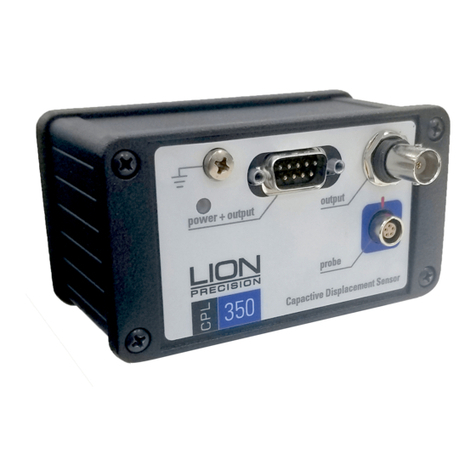
Lion Precision
Lion Precision CPL350 User manual
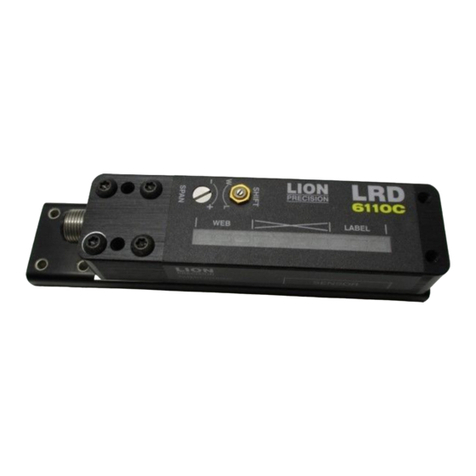
Lion Precision
Lion Precision LRD6110 User manual
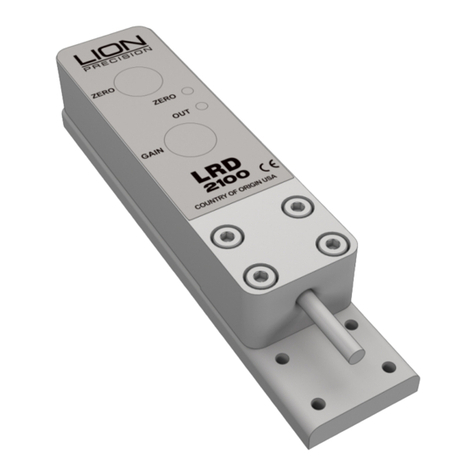
Lion Precision
Lion Precision LRD2100 User manual
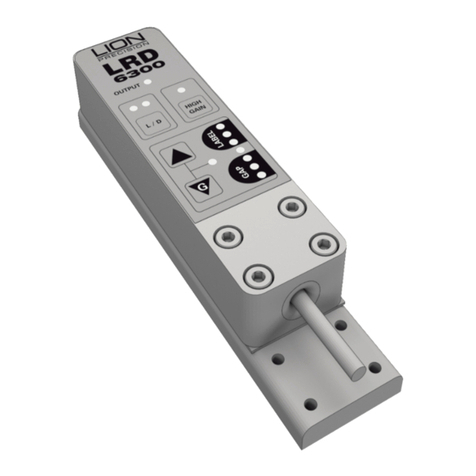
Lion Precision
Lion Precision LRD6300 User manual
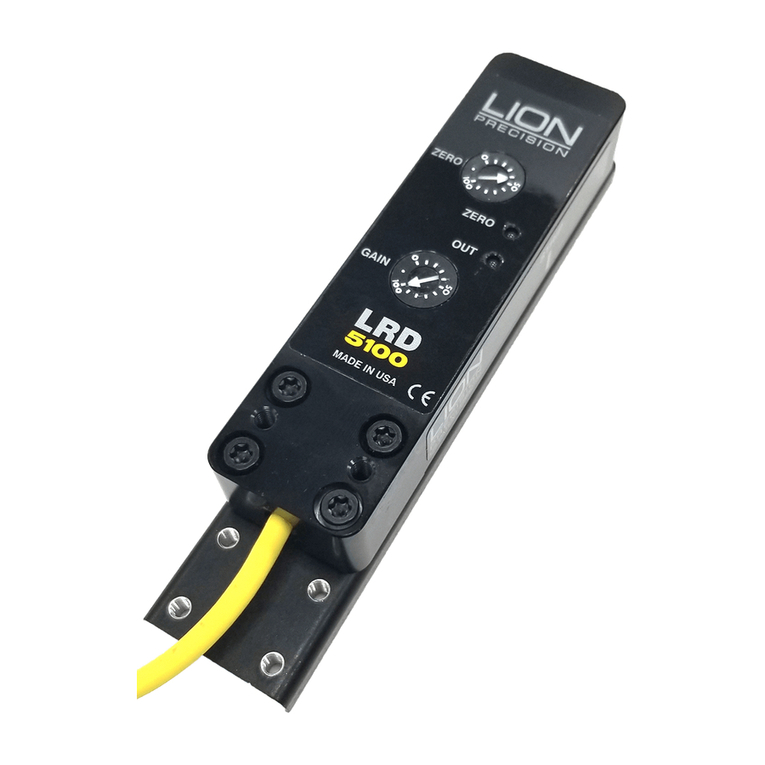
Lion Precision
Lion Precision LRD 5100 User manual
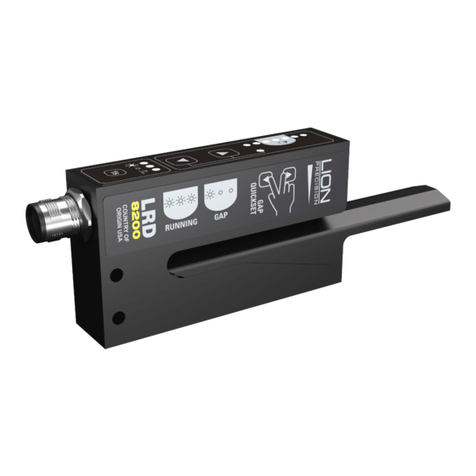
Lion Precision
Lion Precision LRD8200 User manual
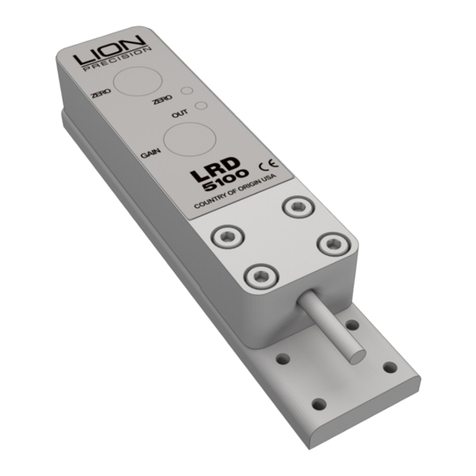
Lion Precision
Lion Precision LRD5100 Tear-Tape User manual

Lion Precision
Lion Precision LRD2100 User manual

Lion Precision
Lion Precision LIONEYE 2 User manual

Lion Precision
Lion Precision LRD6300 User manual
